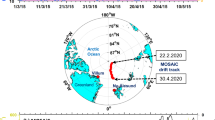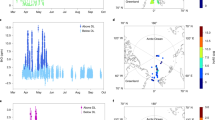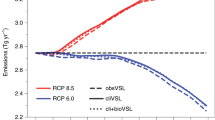Abstract
During the Arctic polar springtime, dramatic ozone losses occur not only in the stratosphere but also in the underlying troposphere1. These tropospheric ozone loss events have been observed over large areas2,3 in the planetary boundary layer (PBL) throughout the Arctic4,5. They are associated with enhanced concentrations of halogen species1,6,7,8,9 and are probably caused by catalytic reactions involving bromine monoxide (BrO) and perhaps also chlorine monoxide (ClO)1,10,11,12. The origin of the BrO, the principle species driving the ozone destruction, is thought to be the autocatalytic release of bromine from sea salt accumulated on the Arctic snow pack10,11,13, followed by photolytic and heterogeneous reactions which produce and recycle the oxide10,11,14,15. Satellite observations have shown the horizontal and temporal extent of large BrO enhancements in the Arctic troposphere16,17, but the vertical distribution of the BrO has remained uncertain. Here we report BrO observations obtained from a high-altitude aircraft that suggest the presence of significant amounts of BrO not only in the PBL but also in the free troposphere above it. We believe that the BrO is transported from the PBL into the free troposphere through convection over large Arctic ice leads (openings in the pack ice). The convective transport also lifts ice crystals and water droplets well above the PBL18,19, thus providing surfaces for heterogeneous reactions that can recycle BrO from less-reactive forms and thereby maintain its ability to affect the chemistry of the free troposphere.
This is a preview of subscription content, access via your institution
Access options
Subscribe to this journal
Receive 51 print issues and online access
$199.00 per year
only $3.90 per issue
Buy this article
- Purchase on Springer Link
- Instant access to full article PDF
Prices may be subject to local taxes which are calculated during checkout



Similar content being viewed by others
References
Barrie, L. A., Bottenheim, J. W., Schnell, R. C., Crutzen, P. J. & Rasmussen, R. A. Ozone destruction and photochemical reactions at polar sunrise in the lower Arctic atmosphere. Nature 334, 138–141 (1988).
Kieser, B. N., Bottenheim, J. W., Sideris, T. & Niki, H. Spring 1989 observations of lower tropospheric chemistry in the Canadian high arctic. Atmos. Environ. A 27, 2979–2988 (1993).
Leaitch, W. R. et al. Airborne observations related to ozone depletion at polar sunrise. J. Geophys. Res. 99, 25499–25517 (1994).
PSE, Polar Sunrise Experiment (PSE 1992), J. Geophys. Res. 99(1994).
Solberg, S., Schmidbauer, N., Semb, A., Stordal, F. & Hov,Ø. Boundary-layer ozone depletion as seen in the Norwegian Arctic in spring. J. Atmos. Chem. 23, 301–332 (1996).
Hausmann, M. & Platt, U. Spectroscopic measurement of bromine oxide and ozone in the high Arctic during polar sunrise experiment 1992. J. Geophys. Res. 99, 25399–25413 (1994).
Jobson, B. T. et al. Measurements of C2-C6hydrocarbons during the polar sunrise 1992 experiment: evidence for Cl atom and Br atom chemistry. J. Geophys. Res. 99, 25355–25368 (1994).
Impey, G. A., Shepson, P. B., Hastie, D. R., Barrie, L. A. & Anlauf, K. G. Measurements of photolyzable chlorine and bromine during the polar sunrise experiment 1995. J. Geophys. Res. 102, 16005–16010 (1997).
Platt, U. & Lehrer, E. Arctic Tropospheric Ozone Chemistry (Final Rep. To European Union, Brussels, (1996)).
McConnell, J. C. et al. Photochemical bromine production implicated in Arctic boundary-layer ozone depletion. Nature 355, 150–152 (1992).
Tang, T. & McConnell, J. C. Autocatalytic release of bromine from Arctic snow pack during polar sunrise. Geophys. Res. Lett. 23, 2633–2636 (1996).
Le Bras, G. & Platt, U. Possible mechanism for combined chlorine and bromine catalyzed destruction of tropospheric ozone in the Arctic. Geophys. Res. Lett. 22, 599–602 (1995).
Finlayson-Pitts, B. J., Livingston, F. E. & Berko, H. N. Ozone destruction and bromine photochemistry at ground level in the Arctic spring. Nature 343, 622–624 (1990).
Fan, S. M. & Jacob, D. J. Surface ozone depletion in Arctic spring sustained by bromine reactions on aerosols. Nature 359, 522–524 (1992).
Mozurkewich, M. Mechanisms for the release of halogens from sea salt particles by free radical reactions. J. Geophys. Res. 100, 14199–14207 (1995).
Richter, A. et al. GOME observations of tropospheric BrO in northern hemispheric spring and summer 1997. Geophys. Res. Lett. 25, 2683–2686 (1998).
Wagner, T. & Platt, U. Satellite mapping of enhanced BrO concentrations in the troposphere. Nature 395, 486–470 (1998).
Andreas, E. L., Miles, M. W., Barry, R. G. & Schnell, R. C. Lidar-derived particle concentrations in plumes from Arctic leads. Ann. Glaciol. 14, 9–12 (1990).
Schnell, R. C. et al. Lidar detection of leads in Arctic sea ice. Nature 339, 530–532 (1989).
McElroy, C. T. Aspectroradiometer for the measurement of direct and scattered solar irradiance on-board the NASA ER-2 high-altitude research aircraft. Geophys. Res. Lett. 22, 1361–1364 (1995).
McElroy, C. T., Midwinter, C., Barton, D. V. & Hall, R. B. Acomparison of J-values estimated by the composition and photodissociative flux measurement with model calculations. Geophys. Res. Lett. 22, 1365–1368 (1995).
McKinney, K. A., Pierson, J. M. & Toohey, D. W. Awintertime in situ profile of BrO between 17 and 27 km in the Arctic vortex. Geophys. Res. Lett. 24, 853–856 (1997).
Beg, W. B., Sperry, P. D., Rahn, K. A. & Gladney, E. S. Atmospheric bromine in the Arctic. J. Geophys. Res. 88, 6719–6736 (1983).
Parungo, F. C. et al. Individual particle analyses of Arctic aerosol samples collected during AGASP-II. Atmos. Environ. A 27, 2825–2837 (1993).
Serreze, M. C. et al. Theoretical heights of buoyant convection above open leads in the winter Arctic pack ice cover. J. Geophys. Res. 97, 9411–9422 (1992).
Scientific Assessment of Ozone Depletion: 1994 (Rep. No. 37, World Meteorological Organization, Geneva, (1995)).
Warneck, P. Chemistry of the Natural Atmosphere (Academic, San Diego, (1988)).
Dibb, J. E. et al. Estimation of stratospheric input to the Arctic troposphere: 7Be and 10Be in aerosols atAlert, Canada. J. Geophys. Res. 99, 12855–12864 (1994).
McKenzie, R. L. et al. Altitude distributions of stratospheric constituents from ground-based measurements at twilight. J. Geophys. Res. 96, 15499–15511 (1991).
McLinden, C. A. et al. J. Atmos. Sci. (in the press).
Acknowledgements
We thank NASA/Ames and Lockheed Aircraft Corp. operations staff and S. E. Gaines for generating and providing the aircraft position data used in this study. POLARIS project flight operations costs were supported by the NASA Office of Earth Sciences' Upper Atmosphere Research Program and the NASA High Speed Research Program. We thank the pilots of the ER-2 whose skill made these measurements possible. J.McC. thanks the Natural Sciences and Engineering Research Council of Canada and the Atmospheric Environment Service of Canada for support. We also thank A. Tang and L.Barrie for discussions.
Author information
Authors and Affiliations
Corresponding author
Rights and permissions
About this article
Cite this article
McElroy, C., McLinden, C. & McConnell, J. Evidence for bromine monoxide in the free troposphere during the Arctic polar sunrise. Nature 397, 338–341 (1999). https://doi.org/10.1038/16904
Received:
Accepted:
Issue Date:
DOI: https://doi.org/10.1038/16904
This article is cited by
-
Molecular dynamics simulations of the evaporation of hydrated ions from aqueous solution
Communications Chemistry (2022)
-
Substantial contribution of iodine to Arctic ozone destruction
Nature Geoscience (2022)
-
A global model study of natural bromine sources and the effects on tropospheric chemistry using MOZART4
Journal of Atmospheric Chemistry (2013)
-
Selected topics in arctic atmosphere and climate
Climatic Change (2012)
-
An ozone depletion event in the sub-arctic surface layer over Hudson Bay, Canada
Journal of Atmospheric Chemistry (2007)
Comments
By submitting a comment you agree to abide by our Terms and Community Guidelines. If you find something abusive or that does not comply with our terms or guidelines please flag it as inappropriate.



